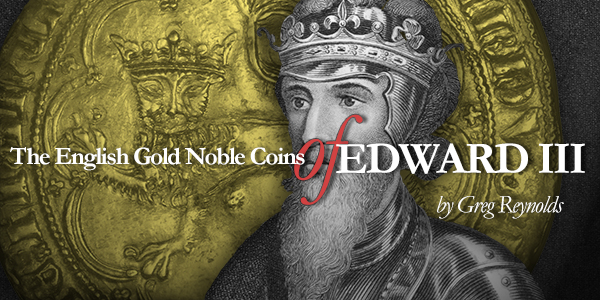Coin Rarities & Related Topics: News and Analysis regarding scarce coins, coin markets, and the coin collecting community #342
A Weekly CoinWeek Column by Greg Reynolds ……
English Noble gold coins minted during the era of King Edward III are historically important, attractive, intricately designed and modestly priced in contrast to rare gold coins of later centuries, especially in comparison to 18th-century U.S. gold coins. Edward III was king of England from 1327 to 1377.
Understandably, collectors may become confused by reference guides, which emphasize subtle varieties that few collectors care about. The main point here is to provide an introduction to the Nobles, Half-Nobles and Quarter-Nobles of King Edward III. These are the first of the long-lasting Noble series.
Even more importantly, Edward III Nobles are the first widely-used gold coins struck in England or in any other part of the British Isles.
It is suggested that the interested collector acquire one of each denomination: a Quarter-Noble, a Half-Noble and a Noble, all from the London Mint. Under King Edward III, coins of all three denominations were struck at the Calais Mint as well, though these are rarer and usually more expensive. A Noble from Calais could be added to a collection for historical reasons.
Auction records in the U.S. are typically for relatively high-quality Edward III coins. When available, well-worn or problematic Nobles may be purchased privately for prices that are much lower than coins of the same varieties that have been certified as grading from AU-58 to MS-65. Indeed, attractive, circulated Nobles or those with edge problems often cost much less than higher quality pieces.
Even when buying Nobles with problems, it is probably a good idea to buy those that are PCGS- or NGC-certified. Although the certified grades of many coins are not agreed upon by leading dealers or relevant experts, buying PCGS- or NGC-certified coins involves much less risk than purchasing non-certified coins or coins that are certified by services that are not as well accepted by people who spend large sums on coins.
Also, even in situations where graders at PCGS or NGC make mistakes, the holders have significant values in coin markets. Non-certified coins valued at more than US$500 are far more likely to have serious problems or be fake than PCGS- or NGC-certified coins, on average.
Besides, it is impossible to eliminate all risk. Collectors should communicate with and pose questions to coin professionals.
Basic Set Best For Most Collectors
The initial gold coins of Edward III, the Leopards before the Nobles, are non-collectible. There are Double Leopards, (single) Leopards and Half-Leopards (‘Helms’). These are among the rarest of all English coins.
Only one Double Leopard is privately owned. It was NGC-graded as “MS-62” in June. Ira Goldberg recently arranged for it to be placed in a major collection. In 1344, Leopards were minted for a matter of weeks and then discontinued.
The British Museum website states that the Double Leopard’s “face value was higher than the value of the gold. Also, a coin worth six shillings did not fit well into the English monetary system, with 20 shillings [=240 pence] in the pound, or 13s 4d [= 160 pence] in the Mark. It was soon replaced by the Noble, a coin worth 6s 8d [= 80 pence] which, being worth a third of a pound, and half a Mark, was much more useful.”
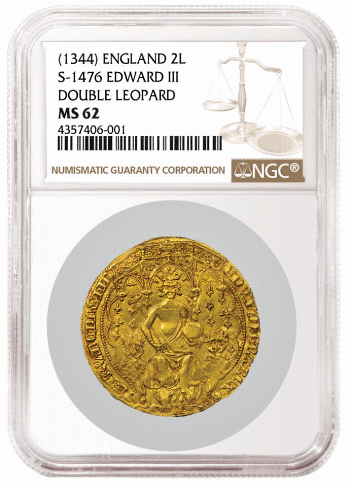 A properly defined subtype (or “type”) set of Edward III Nobles would be hard to explain, awkward to precisely list, and confusing for beginners. For the whole span of production during the reign of Edward III, 1344 to ’77, the general artistry of Nobles remained the same.
A properly defined subtype (or “type”) set of Edward III Nobles would be hard to explain, awkward to precisely list, and confusing for beginners. For the whole span of production during the reign of Edward III, 1344 to ’77, the general artistry of Nobles remained the same.
The Noble denomination outlived King Edward III. Nobles, Half-Nobles and Quarter-Nobles continued to be minted under the reigns of Richard II (ruled 1377-99), Henry IV (1399-1413), Henry V (1413-22), Henry VI (from 1422-1461) and Edward IV (1461-1470). Nobles were replaced by other denominations around 1464.
Although Henry VI and Edward IV each had second reigns as king, respectively, Nobles were not revived. The Edward IV gold Angel had the same nominal face value as a Noble, 80 pence, though was smaller and lighter than a Noble.
A point here is that, rather than collect subtypes of Edward III Nobles, after acquiring three or four from the reign of Edward III, a collector may then collect Nobles from the following eras and build a general set of all Nobles.
The distinct subtypes of Edward III Nobles are largely defined by differences in the legends. Unfortunately, however, the letters are often weakly struck, poorly prepared on the dies, malformed because of problematic planchets or barely legible for other reasons. In some cases, entire words are missing from uncirculated coins or are illegible.
It takes time and training to tell which Edward III Nobles mention France or Aquitaine in the legends. Besides, the Latin phrases and even the shapes of the letters in the titles are archaic and difficult to remember.
For those who really wish to specialize, a true set of important subtypes of Edward III Nobles, including all three denominations, would consist of at least 14 coins and might be practical. To start with English hammered gold, it is best to just buy four coins: a London Mint Edward III Noble, Half-Noble and Quarter-Noble, plus a Noble or Quarter-Noble struck at Calais.
Edward III Introduced First Large Gold Coins of England
The regime of Edward III was the first in England to produce substantial gold coins. Edward III Nobles were produced in quantities suitable for banking, savings and large transactions.
As they were struck with hammers, the diameters of full Nobles vary, though they are generally similar to that of U.S. $20 double eagle gold coins. The diameters of Half-Nobles likewise are similar to that of U.S. $10 gold coins (eagles). Quarter-Nobles are similar in size to U.S. half eagles.
Admittedly, I have never measured the diameter of a Noble. My sources for diameters are the Metropolitan Museum of Art, Wikipedia, Richard Lobel’s book, and publicly-available material by Carl Savage.
The weight standard for Nobles was reduced in 1346 and again in 1351. The standard Spink reference indicates that Nobles of the 1344-46 period weigh or were specified to weigh 138.46 grains (= 0.288 Troy ounce), and then 128.59 grains (0.2677 Troy ounce) from 1346 to 1351.
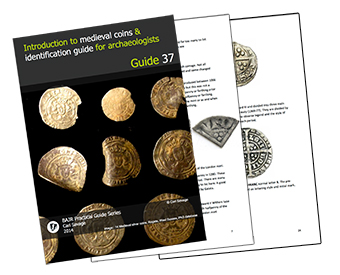 The following Nobles are lighter still. Starting at some point in 1351, each Noble of the 1351 to ’61 period was struck with the logical weight standard of 120 grains, one-fourth of a Troy ounce. The specification for each Half-Noble was then 60 grains (1/8 of a Troy ounce), and 30 grains for each Quarter-Noble (1/16).
The following Nobles are lighter still. Starting at some point in 1351, each Noble of the 1351 to ’61 period was struck with the logical weight standard of 120 grains, one-fourth of a Troy ounce. The specification for each Half-Noble was then 60 grains (1/8 of a Troy ounce), and 30 grains for each Quarter-Noble (1/16).
The use of multiples or fractions of eight is not arbitrary. Before the U.S. adopted a decimal system for coinage, very few people thought of a decimal system as being appropriate for coinage or a monetary system. For many centuries, the English tended to compute with threes and fives; standards were often geared towards multiples of three, especially 12.
In Spain and some other places in Europe, multiples of eight and eighths were the standard practice. Indeed, for centuries the Spanish monetary system was figured in eights (please see last week’s article on the coins of the Central American Republic).
When I examine Nobles, I usually focus on quality and striking characteristics rather than think about their diameters or weights. To English merchants during the 1300s, however, Nobles were very large and impressive gold coins. They must have been stunning. Additionally, the Nobles of Edward III were demanded by merchants and traders throughout much of Europe and the Middle East. Nobles became an international currency.
Previously, most gold pieces struck in England were very small. Importantly, there is not much evidence of any gold pieces struck in England actually circulating as mediums of exchange before Edward III became king. They may have been used for ceremonial purposes or awarded as medals.
Before the 20th century, gold coinage was tied to the wealth, influence and prestige of a nation. The fact that Edward III Nobles were large gold coins that widely circulated (firsts for England) is very much relevant to the rise of England as a world power–militarily and economically–and to the development of English society. Undoubtedly, business people and wealthy consumers were very proud to use gold coins of their own nation.
Ongoing Conflict with France Affected Coinage
The English military was particularly aggressive under Edward III. Indeed, during several campaigns, Edward III personally led or oversaw troops invade parts of the geographical area that now constitutes France. In terms of geography, the current nation of France is not dramatically different from the concept of France in medieval times.
Before Edward III became king, Aquitaine came under English rule. Aquitaine is politically and historically important for several reasons, especially for its strategic location and natural resources. Also, the wines of Bordeaux are produced in the area.
Traditionally, Aquitaine has been part of France, and is so today. The region of Aquitaine is in the most southwest portion of France, bordering the Atlantic Ocean and Spain. The precise historical boundaries of Aquitaine and other entities changed over time, and were often affected by marriages among royals or negotiations between monarchs. Major changes in borders, however, were usually determined by warfare.
Any suggestion by historians that the competition between England and France was a stalemate or a ‘draw’ during Edward’s rule would be very misleading. Edward III was seeking to totally conquer much of the region that constitutes present-day France, and the French were almost always on the defensive.
Edward’s greatest military accomplishment directly relates to coins that collectors may acquire now. His regime established a sizable English town at the port of Calais, formerly and currently part of France. Calais was then one of the most strategic locations in Europe.
According to Wikipedia and other sources, after Edward III transformed Calais into an English town, Calais “grew into a thriving center for wool production. The town came to be called the ‘brightest jewel in the English crown’ owing to its great importance as the gateway for the tin, lead, lace and wool trades.”
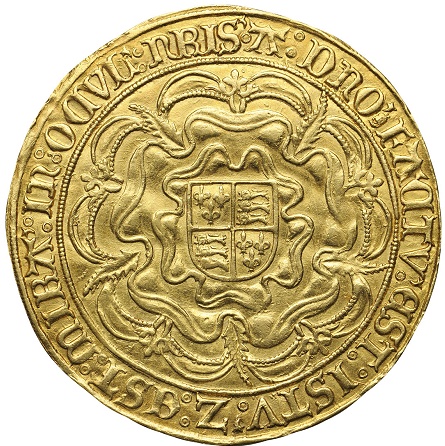 The English forces of Queen Mary I lost Calais in 1558. If Napoleon had invaded Great Britain in the early 1800s, Calais would probably have served as the launching pad. During World War II, the Nazis made a point of demolishing Calais and constructed heavily fortified bunkers there.
The English forces of Queen Mary I lost Calais in 1558. If Napoleon had invaded Great Britain in the early 1800s, Calais would probably have served as the launching pad. During World War II, the Nazis made a point of demolishing Calais and constructed heavily fortified bunkers there.
England established an official mint at Calais. Some silver coins of Calais can be purchased for less than $200 each.
The signing of a treaty with France in 1361 resulted in the English renouncing their claim to all of France. So, on coins, the declaration that the King of England is also the King of France was removed in 1361. The English, though, still maintained Aquitaine and Calais. On the transitional Nobles of 1361, Aquitaine is explicitly referenced though France is not.
At some point in 1369, relations with France worsened and the claim of King Edward III to all of France was restored to the legends on English coinage. The ‘Post-Treaty Period’ lasted form 1369 to Edward’s death in 1377.
Auction Results
Admittedly, when I recently analyzed auction appearances of Nobles and sought other data, I became aware that I had under-estimated the rarity of these.
I personally examined many of them, especially from 2007 to 2010. Strangely enough, I did not realize that I saw a noteworthy percentage of those that survive, including many of the highest quality pieces. Now that I am aware of their rarity, I am more enthusiastic about recommending them, though I am embarrassed to acknowledge that collecting them is likely to be more difficult than I had thought. Edward III Nobles do not appear all that often.
Of all Nobles (not just those of Edward III), NGC has graded 40 Quarter-Nobles, 28 Half-Nobles and 113 full Nobles. Certainly, less than two-thirds of these are Edward III Nobles.
PCGS seems to be reporting 16 Edward III Quarter-Nobles, eight Edward III Half-Nobles, and around 50 Edward III Nobles. Of course, there are many Nobles that have never been submitted to PCGS or NGC.
It is fair to hypothesize that at least 15% have been PCGS- or NGC-graded. There could be large groups in England or Europe of which I am not aware. In terms of gradable coins that have been available to collectors over the past two decades, each of the three denominations are truly rare.
From a logical perspective, current market prices are good values. These are the first series of widely-circulating gold coins of England and are indicative of the rise of England as a major power.
Last month, on June 7, the Goldbergs auctioned a NGC-graded MS-62 Quarter-Noble (1361-69) for $1,586. On September 2, 2014, the Goldbergs auctioned a NGC-graded MS-64 Quarter-Noble (1361-69) for $3,408. Both of these were struck in London.
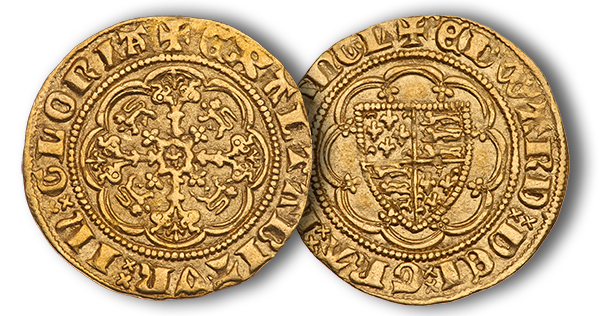
In June 2013, the Goldbergs auctioned a Quarter-Noble that is in a PCGS genuine holder and is said to have “filed rims.” Although this would be a serious problem for a U.S. coin, it is not unusual for an English gold coin that is centuries old. As this coin appears to have the level of wear of an AU-58 grade and be relatively original, it might have been a good deal for $1,035.
Edward III Half-Nobles tend to range in price from $1,000 to $6,500. In January 2015, the Goldbergs auctioned a PCGS-graded AU-53 Half-Noble (1351-61), with a sticker of approval from Wings, for $2,938.
In August 2013, Stack’s-Bowers sold a Half-Noble with problems for less than $500. In August 2011, Stack’s-Bowers auctioned a NGC-graded MS-62, transitional (1361) Half-Noble for $2,875.
At auctions in the U.S., Edward III Nobles tend to sell for prices from $1,000 to $10,000, usually from $2,000 to $7,000. High-grade certified pieces may sell for much more than $10,000.
The rarity of the subtype and the quality of the respective coin are important variables. Coins that do not show obvious signs of dipping or wiping tend to bring premiums. A Noble with very serious problems may possibly bring less than $1,000.
In August 2011, Stack’s-Bowers auctioned a Noble (1351-61) that was in an NGC holder, which indicated that it has the ‘details’ of a Very Fine grade. It realized $1,725.
In January 2016, Stack’s-Bowers auctioned a better Noble of the same variety, probably struck in 1351 or ’52. It was PCGS-graded MS-63 and sold for $7,050. During the same month, at the same location in New York, Heritage auctioned a NGC-graded MS-62 Noble for the exact same price, $7,050. This was one of the best struck Nobles that I have ever seen, from any time period.
In June 2014, the Goldbergs auctioned a Noble of the pre-treaty period (1351-61) that has serious problems, including a hole. It has the details of a Very Fine or better grade coin. The price realized was $1,175. In August 2013, Stack’s-Bowers auctioned a PCGS-graded AU-58 Noble, also of the pre-treaty (1351-61) period, for $3,290.
In September 2011, Heritage auctioned a ‘Treaty Period’ (1361-69) Quarter-Noble from the Calais Mint. It was NGC-graded MS-62 and realized $2,530. In August 2015, Stack’s-Bowers sold a ‘Treaty Period’ (1361-69) Noble from the Calais Mint. The NGC holder includes a notation, ‘Unc Details, Mount Removed.’ It brought $4,700.
Although a Quarter-Noble occasionally sells for less than $1,000, it is certainly true that Edward III gold coins tend to sell for thousands. Given that there are so many U.S., Russian and Chinese coins from past centuries that sell for thousands or even hundreds of thousands of U.S. dollars (or equivalent sums), prices between $2,000 and $10,000 do not seem high or unreasonable for very historically-important gold coins from the 1300s!
©2016 Greg Reynolds


